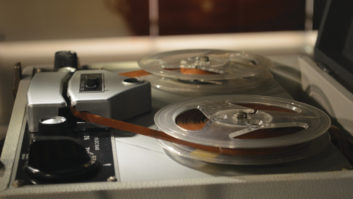Many broadcasters have discovered the unique IP audio products manufactured by Switzerland-based Barix. I have used several in my day-to-day work and introduced them to colleagues.
(click thumbnail)
The KPCW remote 3G package uses a Barix 100 Instreamer, Linksys Router and Verizon 3G card.

I have used the Barix 100 Instreamer for radio streaming, and the Instreamer and Exstreamer to monitor an FM translator network 600 miles away. Recently, Barix made configuring its products easier with a Reflector service; now it has introduced a new product, the Barix 500 Exstreamer.
The Barix 500 has similarities to the Barix 1000, less the AES/EBU interface; it also comes with a lower price tag ($595). Unlike other Exstreamer family products, the Exstreamer 500 and Exstreamer 1000 can both encode and decode audio streams. This makes the unit a versatile and powerful IP audio tool.
The Barix 500 features balanced stereo audio inputs and outputs. There is an audio stereo codec (encoder/decoder) for MP3, PCM linear and A-Law, µ-law, 8 kHz–48 kHz sample rate support. IP communication is achieved with a 10/100 Mbps Ethernet interface. Another feature is a USB 1.1 interface for flash memory drives (FAT16/32 file system support). The power supply input accepts a range of voltages with low power consumption.
Other features include two independent serial ports, RS-232 and RS-485, IR decoding capability with optional serial port IR receiver and four contact closure inputs and four relay outputs.
Balanced audio is available on a nine-pin D-sub connector which, in our case, breaks out to XLR connectors. It would be nice if Barix could integrate the XLR connectors with the chassis. Also, power for the unit is via a Phoenix-type connector; again a less awkward connector might work better for remote use.
As expected, the quality of the audio transmitted by the 500 is a function of the speed of the Internet connection. Our tests were conducted using wired Internet, Wi-Fi, IP bridge and a 3G router. With good connectivity, we could achieve ISDN-quality audio in both directions. The Reflector service made connections easy. The user goes to the Barix Reflector online site, registers and enters each unit’s MAC address, encoder or decoder setting, buffer latency, audio quality and audio levels.
Unfortunately, only one direction of audio can currently be established with the Reflector service. Barix should modify the service to allow bidirectional transmission. The bidirectional feature could then be used for a mix-minus feed from the studio during a remote. It would be good to be able reduce the latency on the mix-minus feed, a sacrifice in audio quality would be an acceptable trade-off for me.
I am working on a project that will use a Barix Exstreamer 100 to feed a reserved-band translator station and an Instreamer 100 to provide a confidence feed of the translator off-air audio back to the studio. The Exstreamer will be fed by the same Instreamer we use for Internet streaming, thanks to the Barix Reflector.
To summarize, the Barix 500 is a versatile IP audio tool that will find its way into many applications, including remote broadcast. The unit is attractively priced and, when used with the Barix Reflector service, easy to set up.
In practice
So how did we put it to work?
KPCW(FM) is a community FM radio station located in scenic Park City, Utah. The staff is a mix of paid professionals and volunteers. The programming can best be described as “full-service eclectic.”
Broadcast engineer Roger Crawford lives in Summit County near Park City and loves remote broadcasts. He works as a senior video engineer for ESPN, travelling the country televising live sports events. But Roger’s avocation is radio, and it was in radio in San Bernardino, Calif., that he started his broadcasting career.
Knowing this, we got him involved in volunteer work at KPCW. When not travelling for ESPN, he would work as a fill-in DJ or help out with engineering projects. Roger let it be known that he “loves remote broadcasts” and wanted to do something to improve the coverage of Park City High School football broadcasts.
We used a Marti RPU transmitter when the football team was at home, but on the road, the announcers would call the game via a cellphone interface. The away game audio quality was pretty bad and it was time for improvement. As KPCW’s chief engineer, I didn’t have the budget to follow the team and engineer their away games, but Roger jumped in to see what he could do.
The first thing Roger did was go to his basement equipment bone pile and put together a remote program mix and monitor kit. Next he pulled out his Barix Exstreamer 100 and Instreamer 100. I’d introduced Roger to these units and once hooked, he had to buy a pair to play with.
Roger’s goal was unspoken: to do a network-quality broadcast from small-town Utah. He visited the football venues before the games, performing site surveys, checking for Internet connectivity, Marti paths, power drops, etc. He would arrive at the venues hours before the games to setup the gear and “fax” (facility check) the audio and mix-minus feeds to and from the studio.
Product Capsule Barix 500 Exstreamer Network Audio Encoder/Decoder
Thumbs Up
• Encoder and decoder in one box
• Balanced inputs and outputs
• Simple to use, rock-solid in performance
• Barix’s Reflector Service
Thumbs Down
• Basic Reflector service is unidirectional
Price: $595
For information, contact Andy Stadheim at Barix Technology in Minnesota at (866) 815-0866 or visit www.barix.com.
He used the Barix 100 units on the road but wasn’t always sure what he would find for an Internet connection at the stadiums. He then discovered that many of the away venues had Verizon 3G coverage, so he borrowed my Linksys WRT54G3G-VN router and Verizon 3G card.
Once active, the Linksys router would provide Internet connectivity to the Barix Instreamer. The Barix Reflector would then automatically connect the Instreamer to a Barix Exstreamer back at the studio. At the studio, the Exstreamer converted the IP stream back to audio. It doesn’t get much easier.
The quality of the audio depended on the quality of the Internet connection. Most of the time it was very good, but occasionally the audio stream would break up or “buffer” due to constraints with the 3G network.
Roger said he found it quite easy to use the Barix 100 and 500 boxes, especially with the Barix Reflector service.
“Mike Gerdes, program manager for KPCW commented that the quality on some of the games was as good as ISDN,” he said. “The only limitation was only the speed of the Internet service available. Hopefully with the coming 4G wireless systems that won’t be a problem anymore.”
Through Barix’s U.S. office, we were able to get a demo of the new Barix Exstreamer 500 unit. This unit is like having both an Instreamer and Exstreamer in the same box with balanced audio ins and outs to boot. Using the Barix 500 on the football remotes, we found that we could only configure one direction of the audio feed through the Barix Reflector service.
It would have been nice to use the other side of the 500 for mix-minus audio from the studio, as I mentioned. Perhaps Barix will add this feature to the Reflector service. (Ed.: Barix says it offers an upgraded bidirectional premium service, Barix STL Pro.)
I’ve always believed that radio is more interesting when it gets out of the studio and having the Barix product line makes that easier and affordable. With IP circuits ubiquitous, 3G showing up in more places and the introduction of the Barix Reflector service, there is now no excuse to not get out of the studio and go do that remote.
Mario Hieb, P.E. is a consulting engineer and chief engineer of KPCW, Park City, Utah.







